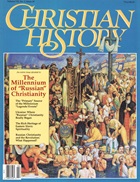Ever since the beginnings of the USSR, religion there has stood on shaky ground. Communist ideology says religion can be either used or abused, depending on which will best meet the state’s ends. With this ambivalence increasing the complexity of church-state relations in the USSR, what really is the situation today?
The relationship that exists today between the Soviet government and the religious groups within its territories, despite some recent appearances of concord surrounding the millennium celebrations, is actually one still characterized by constant uncertainties, frequent hostilities, mutual distrust and much “bad blood.” The observance of the millennium has brought an apparent calm on the surface of the water, but according to several sources, it has really done little to ensure any regularity in the unpredictable currents beneath.
Nonetheless, religion is obviously still an important part of the lives of millions of Soviet citizens. According to recent estimates from the Soviet Council of Religious Affairs (the state organization that monitors all religious activities in the USSR), religious believers make up between 10 and 20 percent of the population. With a population of more than 283 million, this would put the total number of religious believers at between 28 and 56 million.
Well, It Depends
The predominant religious affiliations of Soviet citizens vary by republic. Orthodoxy is the prevalent religion in Russia, Armenia, Byelorussia, Georgia, Moldavia and Ukraine; believers in the Baltic states of Estonia and Latvia are predominantly Lutheran; Lithuania is strongly Catholic; and the Middle Eastern republics of Azerbaijan, Kazakhstan, Kirghizia, Tadzhikistan, Turkmen and Uzbekistan are almost completely Muslim. In addition, large numbers of Baptists, Pentecostals, Seventh-Day Adventists, Jehovah’s Witnesses and Jews are scattered throughout the country.
In a recent interview, Konstantin Kharchev, chairman of the Council of Religious Affairs (CRA), released the official statistics on the number of religious communities that is, churches or synagogues—in the Soviet Union. According to the report, most religious faiths have experienced declines since 1971 (see chart).
But while his figures show a decline, they actually raise more questions about the situation than they answer. In some cases, for example with the Jehovah’s Witnesses, the numbers include congregations that are not officially registered with the government. However, some unregistered denominations, such as the Ukrainian Catholics’, which is outlawed in the Soviet Union, are not mentioned at all, yet are too numerous to be included in the “Others” category. The government puts the number of Baptist congregations at 2,976. However, the Baptists themselves claim more than 5,000 registered congregations, in addition to approximately 2,000 unregistered congregations.
The Soviet government has the final say as to whether a congregation can be legally registered. Many congregations, including the entire Ukrainian Catholic denomination, have been trying for years to register with the CRA—but they have been denied registration. Because of this arrangement, the CRA can easily control the official tally of churches.
This desire for control typifies the Soviet government’s attitude toward religious groups in the Soviet Union. The church there is forced to choose between registering with the government and allowing a certain amount of interference in its affairs, or refusing to register and risking fines and arrests for breaking the Soviet law against unregistered religious activities.
The government-endorsed millenium celebration is an example of the Soviets’ attempt to manipulate religion for their own gain. Back in 1986, General Secretary Mikhail Gorbachev and the Soviet Politburo indicated an intention to downplay the millenium and not allow any celebrations.
Now, under the banner of the new policy of glasnost, Gorbachev and the Politburo are officially supporting the Russian Orthodox Church’s planned celebrations. However, this change does not by any means indicate that the government has suddenly adopted a pro-religion stance. Atheism is still a basic tenet of Marxism, and Gorbachev, despite the references he made to God while in Washington for the 1987 summit, has on other occasions made it clear that he is still opposed to religion in general.
Thus what glasnost means in practice is obviously not the same as what its common English definition of “openness” suggests. In point of fact, its literal translation is something more like “publicity” and some Soviets have actually told American observers that glasnost mostly for the West—a public relation program to make Americans and Western Europeans think the Soviets have changed their stance on human and religious rights.
Deep Change, or Superficial?
Nevertheless, Western Christian should be thankful for the opportunities for ministry that have arisen because of glasnost and the celebration of the millennium. Although the millennium is essentially an Orthodox celebration, the concurrent governmental relaxation restrictions generally applies to most Christian denominations in the Soviet Union. It seems the highest levels of the Soviet government are striving to present to the world’s eye a civilized and cordial working relationship between the government and its religious communities.
For example, the Soviets have allotted the Orthodox Church 100,000 newly printed Bibles, and have given the All-Union Council of Evangelical Christian-Baptists permission to import 115,000 more. Furthermore, the government has permitted at least 29 Orthodox churches to re-open within the last three years, and churchmen, usually neither seen nor heard in the media, have suddenly become respectable voices in the Soviet newspapers and television.
Christians such as Orthodox believer Alexander Ogorodnikov, who was released from labor camp in 1987 after serving eight years for religious activities, have written letters to Soviet leaders calling for changes in the laws against religion—and have not as yet been penalized for such audacity.
Many believers have gained early release from labor camps and psychiatric hospitals. And many Christian families are being given exit visas to leave the Soviet Union and live in the West.
But in the background, local persecutions against Christians still go on. In the last few months, the militia has broken up services of unregistered churches in no fewer than 13 towns. The owners of the homes where the services were conducted were fined 100 rubles, or about half a month’s pay. One Christian, within a recent two-year period, was fined 3,000 rubles, or 15 months’ full pay.
The legal bases for these persecutions are statutes enacted by Josef Stalin in 1929. These statutes outlaw all religious activities except Sunday worship services in registered churches. Though the Soviet government now practices selective non-enforcement of these laws, it is significant that they are still on the books. There has been talk of repealing the 1929 legislation, but thus far that talk has not been backed up by any definitive actions.
Under these laws, it is illegal to teach minors about God. Sunday schools are against the law, children cannot legally attend church, and parents cannot legally teach their children about God even in their own homes. Under the new atmosphere in the Soviet Union, many children and young people now attend church. But it is still illegal, and it is uncertain when or if the Soviet government will stop turning the blind eye to these activities and start enforcing the laws again.
The millennium has brought about many positive changes in the atmosphere of the Soviet Union. But only time will tell if these opportunities are to be permanent, or if they will be taken away when the excitement about the millennium dies down and the eyes of the West look away from Soviet religion.
Brad Gillispie is a writer with the Slavic Gospel Association an evangelical missions organization, based in Wheaton, IL., that focuses on the spread of the good news among the Slavic peoples behind the Iron Curtain.
Copyright © 1988 by the author or Christianity Today/Christian History magazine.
Click here for reprint information on Christian History.

Support Our Work
Subscribe to CT for less than $4.25/month




























